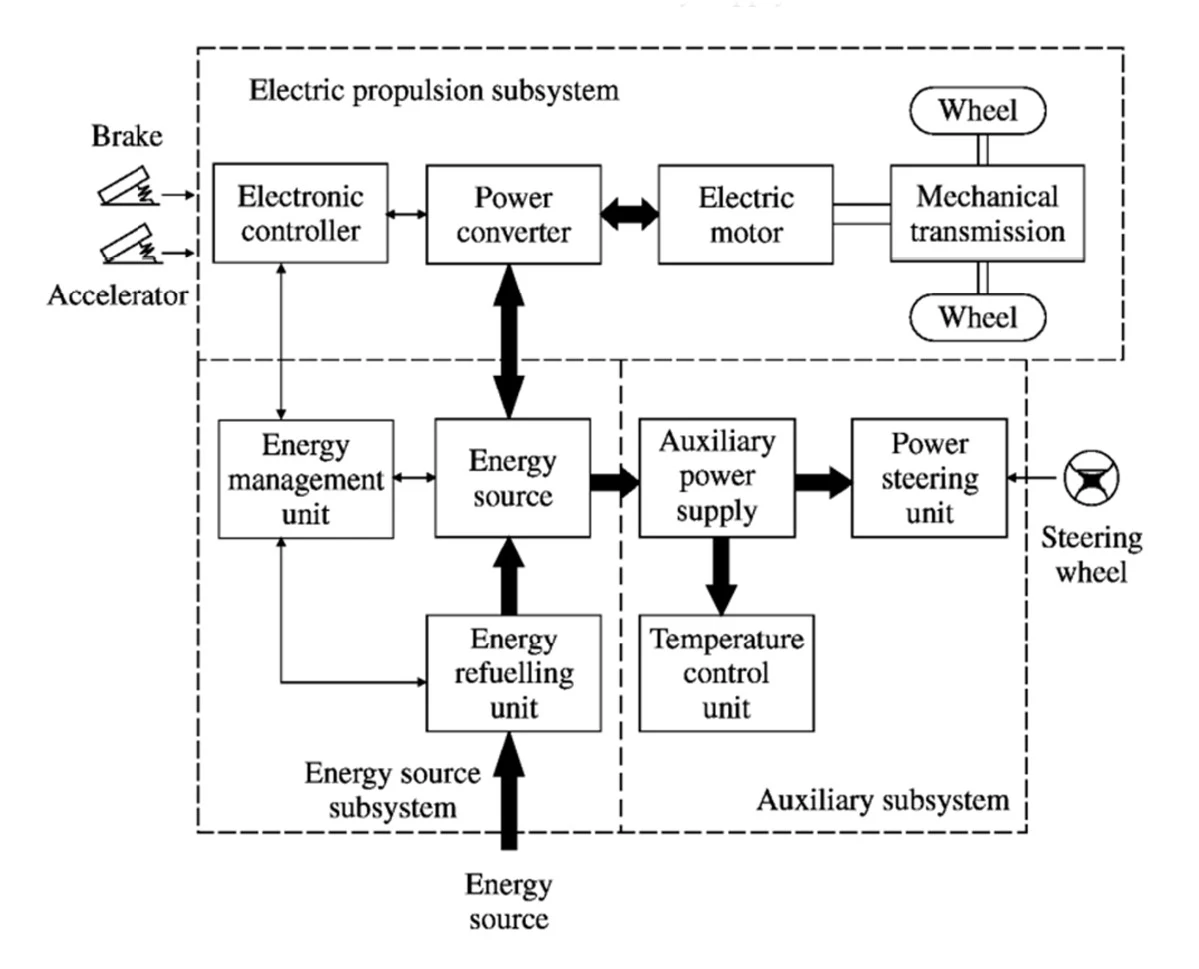EV Overview
Electric vehicles (EVs) use an electric motor for traction, and chemical batteries, fuel cells, ultra-capacitors, and/or flywheels for their corresponding energy sources.
The EV has many advantages over the conventional internal combustion engine vehicle (ICEV), such as absence of emissions, high efficiency, independence from petroleum, and quiet and smooth operation.
The operational and fundamental principles in EVs and ICEVs are similar There are, however, some differences between ICEVs and EVs, such as the use of a gasoline tank versus batteries, ICE versus electric motor, and different transmission requirements
EV Configuration
The EV was mainly converted from the existing ICEV by replacing the IC engine and fuel tank with an electric motor drive and battery pack while retaining all the other components, as shown in Figure 1.1. Drawbacks such as its heavy weight, lower flexibility, and performance degradation have caused the use of this type of EV to fade out. In its place, the modern EV is purposely built, based on original body and frame designs. This satisfies the structure requirements unique to EVs and makes use of the greater flexibility of electric propulsion
A modern electric drive train is conceptually illustrated in Figure 1.2 The drive train consists of three major subsystems: electric motor propulsion, energy source, and auxiliary. The electric propulsion subsystem is comprised of the vehicle controller, the power electronic converter, the electric motor,
mechanical transmission, and driving wheels. The energy source subsystem involves the energy source, the energy management unit, and the energy refueling unit. The auxiliary subsystem consists of the power steering unit, the hotel climate control unit, and the auxiliary supply unit.
EV Advantages
The relative advantages and disadvantages of an EV over an ICEV can be better appreciated from a comparison of the two on the bases of efficiency, pollution, cost, and dependence on oil. The comparison must be executed with care, ensuring fairness to both systems, and the EV advantages is:
- Reduced emission
- High performance and low maintenance
- EV motor are quiet and smooth
- Fast, easy home charging
- The future of driving is electric
EV Market
We normally discuss the use of EVs for passenger and public transportation but tend to forget about their use as off-road vehicles in specialty applications, where range is not an issue. EVs have penetrated the market of off-road vehicles successfully over the years for clean air as well as for cost advantages.
Examples of such applications are airport vehicles for passenger and ground support; recreational vehicles as in golf carts and for theme parks, plant operation vehicles like forklifts and loader trucks; vehicles for disabled persons; utility vehicles for ground transportation in closed but large compounds; etc.
The major impediments for mass acceptance of EVs by the general public are the limited EV range and the lack of EV infrastructure. The solution of the range problem may come from extensive research and development efforts in batteries, fuel cells, and other alternative energy storage devices.
The appropriate infrastructure must also be in place for EVs to become more popular. The issues related to infrastructure are as follows:
- Battery charging facilities: residential and public charging facilities and Stations
- Standardization of EV plugs, cords, and outlets, and safety issues
- Sales and distribution
- Service and technical support
- Parts supply
The current initial cost of an EV is also a big disadvantage for the EV market.
The replacement of the batteries, even for HEVs, is quite expensive, added to which is the limited life problem of these batteries. The cost of EVs will come down as volume goes up, but in the meantime, subsidies and incentives from the government can create momentum.
The increasing use of EVs will improve the job prospects of electrical engineers. The new jobs related to EVs will be in the following areas:
- Power electronics and motor drives: Design and development of the electrical systems of an EV.
- Power generation: Increased utility demand due to EV usage.
- EV infrastructure: Design and development of battery charging stations and of hydrogen generation, storage and distribution systems.
الفرق بين السيارات الكهربائية والسيارات التقليدية داخليا
تستخدم المركبات الكهربائية (EVs) محركًا كهربائيًا للجر والبطاريات الكيميائية وخلايا الوقود والمكثفات الفائقة و / أو الحذافات لمصادر الطاقة المقابلة لها.
تتمتع السيارة الكهربائية بالعديد من المزايا مقارنة بالمركبة التقليدية ذات محرك الاحتراق الداخلي (ICEV) ، مثل عدم وجود انبعاثات ، والكفاءة العالية ، والاستقلال عن البترول ، والتشغيل الهادئ والسلس.
المبادئ التشغيلية والأساسية في EVs و ICEV متشابهة.ومع ذلك ، هناك بعض الاختلافات بين ICEVs و EVs ، مثل استخدام خزان البنزين مقابل البطاريات ، ICE مقابل المحرك الكهربائي ، ومتطلبات نقل مختلفة
اقرأ ايضا








